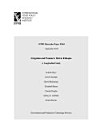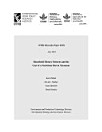Affordability of nutritious diets in rural India
Raghunathan, Kalyani · Headey, Derek D. · Herforth, Anna
Mar 2020 · IFPRI Discussion Paper Book 1 · Intl Food Policy Res Inst
Ebook
54
Pages
family_home
Eligible
info
reportRatings and reviews aren’t verified Learn More
About this ebook
Malnutrition is endemic in India. In 2015-16 some 38% of preschool children were stunted and 21% were wasted, while more than half of Indian mothers and children were anemic. There are many posited explanations for the high rates of malnutrition in India, but surprisingly few discuss the role of Indian diets, particularly the affordability of nutritious diets given low wages and the significant structural problems facing India’s agricultural sector. This study was undertaken to address knowledge gaps around the affordability of nutritious diets in rural India. To do so we used nationally representative rural price and wage data to estimate the least cost means of satisfying India-specific dietary recommendations, referred to as the Cost of a Recommended Diet (CoRD), and assess the affordability of this diet relative to male and female wages for unskilled laborers. Although we find that dietary costs increased substantially over 2001-2011 for both men and women, rural wage rates increased more rapidly, implying that nutritious diets became substantially more affordable over time. However, in absolute terms nutritious diets in 2011 were still expensive relative to unskilled wages, constituting approximately 50-60% of male and about 70-80% of female daily wages, and were often even higher relative to minimum wages earned from the Mahatma Gandhi National Rural Employment Guarantee Act (MGNREGA). Since many poor households have significant numbers of dependents and substantial non-food expenditure requirements, it follows that nutritious diets are often highly unaffordable for the rural poor; we estimate that 45-64% of the rural poor cannot afford a nutritious diet that meets India’s national food-based dietary guidelines. Our results point to the need to more closely monitor food prices through a nutritional lens, and to shift India’s existing food policies away from their heavy bias towards cereals. Achieving nutritional security in India requires a much more holistic focus on improving the affordability of the full range of nutritious food groups and ensuring that economic growth results in sustained income growth for the poor.
Rate this ebook
Tell us what you think.
Reading information
Smartphones and tablets
Install the Google Play Books app for Android and iPad/iPhone. It syncs automatically with your account and allows you to read online or offline wherever you are.
Laptops and computers
You can listen to audiobooks purchased on Google Play using your computer's web browser.
eReaders and other devices
To read on e-ink devices like Kobo eReaders, you'll need to download a file and transfer it to your device. Follow the detailed Help Center instructions to transfer the files to supported eReaders.







